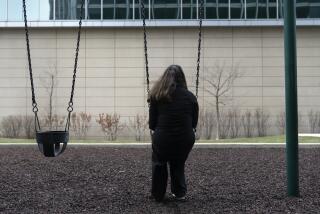Study Shows a Million Teen Suicide Attempts : Health: Data covers American youths in 12-month period. More than a quarter required medical treatment.
- Share via
WASHINGTON — About 1 million American teen-agers attempted suicide during a recent 12-month period and an estimated 276,000 sustained injuries serious enough to require medical treatment, according to a new federal study released Thursday.
“It’s that last number I’m worried about--that’s a lot of kids,” said Dr. Patrick W. O’Carroll, an official of the Atlanta-based Centers for Disease Control. “This is not trivial by any means.”
The CDC, which described the results in its Morbidity and Mortality Weekly Report, based the study on a 1990 survey of a representative sample of American high-school students, who were asked about their experiences during the previous year.
Based on their responses, the CDC estimated that 3.6 million students across the country considered taking their own lives during the 12-month period, while about 2.1 million went so far as to devise a suicide plan. Of those, the agency estimated, about 1 million adolescents actually made an attempt.
Adolescent suicides have been increasing steadily in recent years, according to the CDC. The suicide rate has quadrupled since 1950, rising from 2.7 per 100,000 teen-agers that year to 11.3 per 100,000 in 1988, the agency said. It had no rate for adolescent suicides in 1990.
The new study marks the first time the federal government has gathered data on attempted--rather than completed--suicides over a specific period of time. Several past surveys examining the lifetime prevalence of attempted suicide reported that 9% to 14% of adolescents said they had attempted suicide at some point in their lives.
Attempted suicide is “a risk factor for future completed suicide” and “a potential indicator of other health problems,” such as substance abuse, depression and stress, the report said.
The CDC study is based on interviews of 11,631 students in grades 9 through 12 across the country in 1990. Of those surveyed, 27.3% said they had thought seriously about attempting suicide at some point during the previous 12 months.
Fewer students, 16.3%, reported they had devised a specific plan to attempt suicide. About half of the students who made a plan--8.3% of all respondents--said they had actually tried to commit suicide. And 2% said their attempts to kill themselves had resulted in an injury or poisoning serious enough to require medical attention.
CDC officials said they were surprised that so few suicide attempts had resulted in medical treatment.
“I think that most people intuitively think that if someone says they attempted suicide, they picture ambulances running down the street delivering kids for life-saving treatment,” said O’Carroll, chief of the intentional injuries section of CDC’s National Center for Environmental Health and Injury Control. “This clearly was not going on.”
Nevertheless, he noted, “just because you don’t have to worry that these kids are going to die from suicide, this doesn’t mean you don’t have to worry. These are still kids in trouble who may have some very severe problems.”
Dr. Neil Bernstein, a clinical psychologist who specializes in adolescent behavior, said it is important to draw a distinction between “superficial” and “serious” suicide attempts.
“There is a difference between the young female who takes two pills because she is angry with her parents and wants to make a point and the kid who puts a loaded weapon to his head but doesn’t succeed in killing himself,” said Bernstein, a consultant to the Psychiatric Institute of Washington.
Even so, he said, “any suicidal gesture should--must, ought--to be taken seriously with no exception, even the two pills. There’s a message. The youngster is speaking through actions, not words, and it is a plea for help.”
Dr. David Brent, chief of child and adolescent psychiatry at Western Psychiatric Institute and Clinic in Pittsburgh, agreed that any manifestation of suicidal tendencies is significant.
“I think the fact that young people engage in suicidal behavior is much more informative than how much injury they do to themselves,” he said. “The risk for completed suicides in those kids is very high.”
Several experts said that they did not consider the 3.6-million estimate of the number of students who had considered suicide over a year’s time to be especially shocking. “It’s probably low,” Bernstein said. “Thoughts of suicide don’t hurt. It’s actions that hurt.”
CDC said that females were “significantly” more likely than males to report that they had thought seriously about attempting suicide, made a suicide plan, or attempted suicide one or more times during the 12 months preceding the survey.
Similarly, Latino and white students reported higher levels of suicidal thoughts and behaviors than black students, the report said.
Latino females were “significantly” more likely to have attempted suicide during that period than white or black females, the study said.
CDC said that youth suicide prevention strategies designed to educate young people about the warning signs of suicide and about suicide prevention strategies “have not been widely implemented . . . and little is known about their relative effectiveness.”
More to Read
Sign up for Essential California
The most important California stories and recommendations in your inbox every morning.
You may occasionally receive promotional content from the Los Angeles Times.













